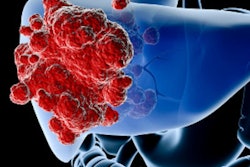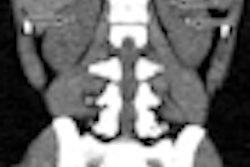A software protocol that enables the use of both automatic tube voltage selection (ATVS) and automatic tube current modulation (ATCM) in the same CT scan can reduce radiation dose significantly in patients with suspected liver disease, according to a new study in Radiology by Korean researchers.
The study team cut dose by up to one-third by using the two techniques together rather than using tube current modulation alone, and contrast-to-noise ratios also were improved with the use of both automated techniques, according to researchers from Seoul National University College of Medicine in South Korea and Siemens Healthcare (Radiology, September 25, 2012).
"The combined use of ATVS and ATCM recommends the tube potential with the lowest radiation dose, estimated on the basis of the patient's topograms, and adjusts the tube current for different patient body habitus during liver CT, consequently leading to an effectively reduced radiation dose while maintaining diagnostic image quality," wrote Dr. Kyung Hee Lee and colleagues.
ATCM, which adjusts tube current based on the size and attenuation of anatomy, is the most frequently used dose reduction method in CT. Reduced tube voltage settings based on patient size also are gaining ground as a method to reduce the dose further, and a recent study on automated tube voltage selection based on commercially available software (Care kV, Siemens) demonstrates that ATVS and ATCM can be used together to minimize dose.
Because the Care kV software measures image quality in contrast-to-noise ratio, Lee and colleagues used this measure in their analysis of patients with suspected liver disease undergoing CT in a study to determine the feasibility of using both techniques to reduce dose while retaining good image quality.
The researchers examined 314 patients (mean age, 59.7 years; age range, 23-87 years; 226 men [mean age, 59.4 years; age range, 23-86 years], and 88 women [mean age, 60.5 years; age range, 28-87 years]) with suspected liver disease and divided them into three groups: two with both ATVS and ATCM. In two groups, both ATVS and ATCM were used with different contrast gain settings (group A1, n = 97; group A2, n = 101), while a third group (group B, n = 116) were scanned using only ATCM at a fixed tube potential of 120 kV.
The quadruple-phase CT exam include precontrast, arterial phase, portal-venous phase, and delayed-phase imaging on a dual-source CT scanner in single-energy mode (Somatom Definition Dual Source CT, Siemens). Lee and colleagues measured weighted CT dose index volume (CTDIvol), dose-length product (DLP), contrast-to-noise ratios (CNRs), and mean image noise in all three groups. Finally, two experienecd radiologists and a radiology resident performed a qualitative analysis of image quality.
The Care kV ATVS software is designed to be used with the Care Dose 4D ATCM application, and automatically recommends the tube voltage setting (80, 100, 120, or 140 kV) that delivers the lowest radiation dose for each patient based on "contrast gain," which the manufacturer defines as the ratio of water or soft-tissue attenuation difference at a given tube voltage relative to 140 kV, the authors explained. The settings are based on the diagnostic purpose of the exam, which allows the user to define the relative importance of contrast enhancement in a trade-off with image noise.
The results found that the patients groups who received both ATVS and ATCM techniques (groups A1 and A2) had significant dose reductions compared with the group scanned with ATCM alone. The mean dose reduction was 20% (7.7 mGy ± 2.2 for aortic phase, 9.4 mGy ± 1.6 for delayed phase) in group A1, and 31% (6.9 mGy ± 3.3 for aortic phase, 9.6 mGy ± 2.3 for delayed phase) in group A2.
Significant radiation dose reductions were found in all patients except the obese (BMI > 30 kg/m²). The few severely obese patients in the study required higher tube voltage and radiation dose to obtain a similar image quality, the researchers reported. Interestingly, ATVS never recommended the use of 120 kV in the study cohort, they noted. The greatest dose reductions were in underweight and normal-weight patients, in whom the lowest tube voltage was used.
Overall, contrast-to-noise ratio also was significantly higher in groups A1 and A2, compared with group B (p < 0.0001), the authors wrote, although image noise was greater in groups A1 and A2. Overall image quality (based on a scale of 1 to 4, with 4 being optimal) was high, with the highest scores in group A1 (3.21 on arterial phase, p = 0.12; 3.48 on portal-venous phase images, p < 0.0001), compared with group B (3.13 on arterial phase, 3.05 on portal-venous phase images).
"In the qualitative analysis of our study, patients showed neither diagnostically unacceptable range of image noise nor unacceptable image quality in groups A1 and A2 in which ATVS and ATCM were simultaneously used," they wrote.
As for limitations, the study was retrospective and there was no control group, which would have been required to receive substantially higher radiation doses than the study patients, Lee and colleagues noted. In addition, the number of hypervascular hepatocellular carcinomas in the cohort was too small to evaluate detection accuracy, although lesion conspicuity and tumor-to-liver contrast were examined in patients with hypervascular hepatocellular carcinomas.
"The combined use of ATVS and ATCM for liver CT led to significant radiation dose reduction while maintaining acceptable image quality through the suggestion of tube voltage and current with the lowest radiation dose, calculated relative to the patient's body habitus, anatomic region being studied, and clinical indications," the study team concluded.
|
Study disclosure One of the study co-authors was an employee of Siemens Healthcare at the time of the research. |



















